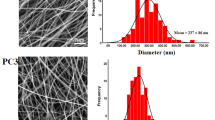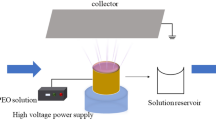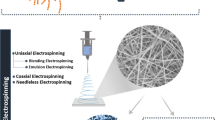Abstract
Food packaging plays a critical role in maintaining the freshness and quality of foods by minimizing oxidation and microbial contamination. Active packaging systems based on biodegradable polymers with green production have received great attention. Here, Melissa officinalis extract (ME) with antimicrobial and antioxidant properties was incorporated into chitosan (Cs)/ polyethylene oxide (PEO) electrospun nanofibers. Nanofibers were fabricated through electrospinning as an efficient and versatile technique with an applied voltage of 18 kV and a tip-to-collector distance of 18 cm. The total phenolic and flavonoid content of ME was measured. By incorporating ME into the nanofibers, the need for synthetic additives or preservatives can be reduced, promoting eco-friendly packaging solutions. The nanofibers were characterized regarding morphology, water contact angle, swelling degree, weight loss, mechanical strength, and vapor permeability. To improve the mechanical properties of nanofibers, photo-cross-linking was applied with benzophenone. Nanofibers were evaluated in terms of antioxidant and antifungal activities as well as their ability to protect edible mushroom quality. ME contained a significant amount of phenolic compounds as well as 1.3 mg caffeic acid/g herbal extract. Cs/PEO/ME nanofibers showed uniform and bead-free structures with an average fiber diameter of 157.7 nm. Photo-cross-linked nanofibers exhibited higher water resistance and mechanical properties compared with the as-spun formulation. ME-loaded nanofibers had higher antioxidant and antifungal activities than the empty formulation. Cross-linked Cs/PEO/ME nanofibers prolonged the shelf life of mushrooms compared to empty mats and plastic films. In conclusion, the multifunctional cross-linked Cs/PEO/ME nanofibers have broad prospects in active food packaging applications.
Graphical Abstract








Similar content being viewed by others
References
Srivastava V, Singh S, Das D (2023) Rice husk fiber-reinforced starch antimicrobial biocomposite film for active food packaging. J Clean Prod 421:138525. https://doi.org/10.1016/j.jclepro.2023.138525
Sharma C, Bhardwaj NK, Pathak P (2021) Static intermittent fed-batch production of bacterial nanocellulose from black tea and its modification using chitosan to develop antibacterial green packaging material. J Clean Prod 279:123608. https://doi.org/10.1016/j.jclepro.2020.123608
Ahari H, Soufiani SP (2021) Smart and active food packaging: insights in novel food packaging. Front Microbiol. https://doi.org/10.3389/fmicb.2021.657233
Jamróz E, Kopel P (2020) Polysaccharide and protein films with antimicrobial/antioxidant activity in the food industry: a review. Polymers 12(6):1289. https://doi.org/10.3390/polym12061289
Olszewska MA, Gędas A, Simões M (2020) Antimicrobial polyphenol-rich extracts: applications and limitations in the food industry. Food Res Int 134:109214. https://doi.org/10.1016/j.foodres.2020.109214
Carvalho F, Duarte AP, Ferreira S (2021) Antimicrobial activity of Melissa officinalis and its potential use in food preservation. Food Biosci 44:101437. https://doi.org/10.1016/j.fbio.2021.101437
Petrisor G, Motelica L, Craciun LN, Oprea OC, Ficai D, Ficai A (2022) Melissa officinalis composition pharmacological effects and derived release systems-a review. Int J Mol Sci. https://doi.org/10.3390/ijms23073591
Yu H, Zhang C, **e Y, Mei J, **e J (2022) Effect of Melissa officinalis L. essential oil nanoemulsions on structure and properties of carboxymethyl chitosan/locust bean gum composite films. Membranes. https://doi.org/10.3390/membranes12060568
Bhatia S, Al-Harrasi A, Alhadhrami AS, Shah YA, Kotta S, Iqbal J, Anwer MK, Nair AK, Koca E, Aydemir LY (2023) Physical, chemical, barrier, and antioxidant properties of pectin/collagen hydrogel-based films enriched with melissa officinalis. Gels. https://doi.org/10.3390/gels9070511
Sani IK, Pirsa S, Tağı Ş (2019) Preparation of chitosan/zinc oxide/Melissa officinalis essential oil nano-composite film and evaluation of physical, mechanical and antimicrobial properties by response surface method. Polym Testing 79:106004. https://doi.org/10.1016/j.polymertesting.2019.106004
Xue J, Wu T, Dai Y, **a Y (2019) Electrospinning and electrospun nanofibers: methods, materials, and applications. Chem Rev 119(8):5298–5415. https://doi.org/10.1021/acs.chemrev.8b00593
Zhang C, Li Y, Wang P, Zhang H (2020) Electrospinning of nanofibers: potentials and perspectives for active food packaging. Compr Rev Food Sci Food Saf 19(2):479–502. https://doi.org/10.1111/1541-4337.12536
Tien ND, Lyngstadaas SP, Mano JF, Blaker JJ, Haugen HJ (2021) Recent developments in chitosan-based micro/nanofibers for sustainable food packaging, smart textiles, cosmeceuticals, and biomedical applications. Molecules 26(9):2683. https://doi.org/10.3390/molecules26092683
Wen P, Zong MH, Linhardt RJ, Feng K, Wu H (2017) Electrospinning: a novel nano-encapsulation approach for bioactive compounds. Trends Food Sci Technol 70:56–68. https://doi.org/10.1016/j.tifs.2017.10.009
Yilmaz MT, Hassanein WS, Alkabaa AS, Ceylan Z (2022) Electrospun eugenol-loaded gelatin nanofibers as bioactive packaging materials to preserve quality characteristics of beef. Food Packag Shelf Life 34:100968. https://doi.org/10.1016/j.fpsl.2022.100968
Zhang D, Chen L, Cai J, Dong Q, Din Z-u, Hu Z-Z, Wang G-Z, Ding W-P, He J-R, Cheng S-Y (2021) Starch/tea polyphenols nanofibrous films for food packaging application: from facile construction to enhance mechanical, antioxidant and hydrophobic properties. Food Chem 360:129922. https://doi.org/10.1016/j.foodchem.2021.129922
Shao P, Liu Y, Ritzoulis C, Niu B (2019) Preparation of zein nanofibers with cinnamaldehyde encapsulated in surfactants at critical micelle concentration for active food packaging. Food Packag Shelf Life 22:100385. https://doi.org/10.1016/j.fpsl.2019.100385
Surendhiran D, Li C, Cui H, Lin L (2020) Fabrication of high stability active nanofibers encapsulated with pomegranate peel extract using chitosan/PEO for meat preservation. Food Packag Shelf Life 23:100439. https://doi.org/10.1016/j.fpsl.2019.100439
Kwak HW, Lee H, Lee ME, ** H-J (2018) Facile and green fabrication of silk sericin films reinforced with bamboo-derived cellulose nanofibrils. J Clean Prod 200:1034–1042. https://doi.org/10.1016/j.jclepro.2018.07.289
Abd El-Hack ME, El-Saadony MT, Shafi ME, Zabermawi NM, Arif M, Batiha GE, Khafaga AF, Abd El-Hakim YM, Al-Sagheer AA (2020) Antimicrobial and antioxidant properties of chitosan and its derivatives and their applications: a review. Int J Biol Macromol 164:2726–2744. https://doi.org/10.1016/j.ijbiomac.2020.08.153
Leceta I, Guerrero P, Cabezudo S, Kdl C (2013) Environmental assessment of chitosan-based films. J Clean Prod 41:312–318. https://doi.org/10.1016/j.jclepro.2012.09.049
Anisiei A, Oancea F, Marin L (2021) Electrospinning of chitosan-based nanofibers: from design to prospective applications. Rev Chem Eng. https://doi.org/10.1515/revce-2021-0003
Lu H, Butler JA, Britten NS, Venkatraman PD, Rahatekar SS (2021) Natural antimicrobial nano composite fibres manufactured from a combination of alginate and oregano essential oil. Nanomaterials (Basel). https://doi.org/10.3390/nano11082062
Pan J, Ai F, Shao P, Chen H, Gao H (2019) Development of polyvinyl alcohol/beta-cyclodextrin antimicrobial nanofibers for fresh mushroom packaging. Food Chem 300:125249. https://doi.org/10.1016/j.foodchem.2019.125249
Zhang Y, Yang K, Qin Z, Zou Y, Zhong H, Zhang H (2022) Cross-linked gluten/zein nanofibers via maillard reaction with the loading of star anise essential oil/β-cyclodextrin inclusions for food-active packaging. Food Packag Shelf Life 34:100950. https://doi.org/10.1016/j.fpsl.2022.100950
Munteanu BS, Vasile C (2021) Encapsulation of natural bioactive Compounds by electrospinning—applications in food storage and safety. Polymers 13(21):3771. https://doi.org/10.3390/polym13213771
Khan S, Khan T, Shah AJ (2018) Total phenolic and flavonoid contents and antihypertensive effect of the crsude extract and fractions of Calamintha vulgaris. Phytomedicine 47:174–183. https://doi.org/10.1016/j.phymed.2018.04.046
Teixeira RSP, Correa RJ, Belvino A, Nascimento RSV (2013) UV Irradiation-induced crosslinking of aqueous solution of poly(ethylene oxide) with benzophenone as initiator. J Appl Polym Sci 130(4):2458–2467. https://doi.org/10.1002/app.39381
Zou Y, Zhang C, Wang P, Zhang Y, Zhang H (2020) Electrospun chitosan/polycaprolactone nanofibers containing chlorogenic acid-loaded halloysite nanotube for active food packaging. Carbohyd Polym 247:116711. https://doi.org/10.1016/j.carbpol.2020.116711
Yildiz E, Sumnu G, Kahyaoglu LN (2021) Monitoring freshness of chicken breast by using natural halochromic curcumin loaded chitosan/PEO nanofibers as an intelligent package. Int J Biol Macromol 170:437–446. https://doi.org/10.1016/j.ijbiomac.2020.12.160
Arabpour Z, Baradaran-Rafii A, Bakhshaiesh NL, Ai J, Ebrahimi-Barough S, Esmaeili Malekabadi H, Nazeri N, Vaez A, Salehi M, Sefat F, Ostad SN (2019) Design and characterization of biodegradable multi layered electrospun nanofibers for corneal tissue engineering applications. J Biomed Mater Res, Part A 107(10):2340–2349. https://doi.org/10.1002/jbm.a.36742
Song X, Liu L, Wu X, Liu Y, Yuan J (2021) Chitosan-based functional films integrated with magnolol: characterization antioxidant and antimicrobial activity and pork preservation. Int J Mol Sci. https://doi.org/10.3390/ijms22157769
Ulu A, Birhanlı E, Köytepe S, Ateş B (2020) Chitosan/polypropylene glycol hydrogel composite film designed with TiO2 nanoparticles: a promising scaffold of biomedical applications. Int J Biol Macromol 163:529–540. https://doi.org/10.1016/j.ijbiomac.2020.07.015
Wen P, Zhu D-H, Wu H, Zong M-H, **g Y-R, Han S-Y (2016) Encapsulation of cinnamon essential oil in electrospun nanofibrous film for active food packaging. Food Control 59:366–376. https://doi.org/10.1016/j.foodcont.2015.06.005
Pirsa S, Karimi Sani I, Pirouzifard MK (2020) Erfani A (2020) Smart film based on chitosan/Melissa officinalis essences/ pomegranate peel extract to detect cream cheeses spoilage. Food Addit Contam Part A Chem Anal Control Expo Risk Assess. https://doi.org/10.1080/19440049.2020.1716079
Sipos S, Moacă EA, Pavel IZ, Avram Ş, Crețu OM, Coricovac D, Racoviceanu RM, Ghiulai R, Pană RD, Şoica CM, Borcan F, Dehelean CA, Crăiniceanu Z (2021) Melissa officinalis L. aqueous extract exerts antioxidant and antiangiogenic effects and improves physiological skin parameters. Molecules. https://doi.org/10.3390/molecules26082369
Deng L, Taxipalati M, Zhang A, Que F, Wei H, Feng F, Zhang H (2018) Electrospun chitosan/poly(ethylene oxide)/lauric arginate nanofibrous film with enhanced antimicrobial activity. J Agric Food Chem 66(24):6219–6226. https://doi.org/10.1021/acs.jafc.8b01493
Estrada-Villegas GM, Del Río-De Vicente JI, Argueta-Figueroa L, González-Pérez G (2020) UV-initiated crosslinking of electrospun chitosan/poly(ethylene oxide) nanofibers doped with ZnO-nanoparticles: development of antibacterial nanofibrous hydrogel. MRS Communications 10(4):642–651. https://doi.org/10.1557/mrc.2020.74
Kohsari I, Shariatinia Z, Pourmortazavi SM (2016) Antibacterial electrospun chitosan-polyethylene oxide nanocomposite mats containing bioactive silver nanoparticles. Carbohydr Polym 140:287–298. https://doi.org/10.1016/j.carbpol.2015.12.075
Kianfar P, Vitale A, Dalle Vacche S, Bongiovanni R (2019) Photo-crosslinking of chitosan/poly(ethylene oxide) electrospun nanofibers. Carbohydr Polym 217:144–151. https://doi.org/10.1016/j.carbpol.2019.04.062
Motahari F, Raisi A (2021) Reducing the crystallinity of high molecular weight poly (ethylene oxide) using ultraviolet cross-linking for preparation of gas separation membranes. J Appl Polym Sci 138(12):50059. https://doi.org/10.1002/app.50059
Bascón-Villegas I, Pereira M, Espinosa E, Sánchez-Gutiérrez M, Rodríguez A, Pérez-Rodríguez F (2022) A new eco-friendly packaging system incorporating lignocellulose nanofibres from agri-food residues applied to fresh-cut lettuce. J Clean Prod 372:133597. https://doi.org/10.1016/j.jclepro.2022.133597
Draginic N, Andjic M, Jeremic J, Zivkovic V, Kocovic A, Tomovic M, Bozin B, Kladar N, Bolevich S, Jakovljevic V, Milosavljevic I (2022) Anti-inflammatory and antioxidant effects of Melissa officinalis extracts: a comparative study. Iran J Pharm Res 21(1):e126561. https://doi.org/10.5812/ijpr-126561
Villalva M, Santoyo S, Salas-Pérez L, MdlN S-S, Rodríguez García-Risco M, Fornari T, Reglero G, Jaime L (2021) Sustainable Extraction Techniques for Obtaining Antioxidant and Anti-Inflammatory Compounds from the Lamiaceae and Asteraceae Species. Foods 10(9):2067. https://doi.org/10.3390/foods10092067
Boneza MM, Niemeyer ED (2018) Cultivar affects the phenolic composition and antioxidant properties of commercially available lemon balm (Melissa officinalis L.) varieties. Ind Crops Prod 112:783–789. https://doi.org/10.1016/j.indcrop.2018.01.003
Móricz ÁM, Lapat V, Morlock GE, Ott PG (2020) High-performance thin-layer chromatography hyphenated to high-performance liquid chromatography-diode array detection-mass spectrometry for characterization of coeluting isomers. Talanta 219:121306. https://doi.org/10.1016/j.talanta.2020.121306
Thakkar S, Misra M (2017) Electrospun polymeric nanofibers: new horizons in drug delivery. Eur J Pharm Sci 107:148–167. https://doi.org/10.1016/j.ejps.2017.07.001
Aman Mohammadi M, Hosseini SM, Yousefi M (2020) Application of electrospinning technique in development of intelligent food packaging: a short review of recent trends. Food Sci Nutr 8(9):4656–4665. https://doi.org/10.1002/fsn3.1781
Ibrahim HM, Klingner A (2020) A review on electrospun polymeric nanofibers: production parameters and potential applications. Polym Testing 90:106647. https://doi.org/10.1016/j.polymertesting.2020.106647
Singh YP, Dasgupta S, Nayar S, Bhaskar R (2020) Optimization of electrospinning process & parameters for producing defect-free chitosan/polyethylene oxide nanofibers for bone tissue engineering. J Biomater Sci Polym Ed 31(6):781–803. https://doi.org/10.1080/09205063.2020.1718824
Elsabee MZ, Naguib HF, Morsi RE (2012) Chitosan based nanofibers, review. Mater Sci Eng, C 32(7):1711–1726. https://doi.org/10.1016/j.msec.2012.05.009
Pakravan M, Heuzey M-C, Ajji A (2011) A fundamental study of chitosan/PEO electrospinning. Polymer 52(21):4813–4824. https://doi.org/10.1016/j.polymer.2011.08.034
Karamat-Iradmousa M, Karimi H, Mahboubi A, Rabbani S, Kamalinejad M, Haeri A (2023) Bi-layered nanofibers loaded with pomegranate flowers extract as a novel wound dressing: fabrication, characterization, and in vivo healing promotion. Ind Crops Prod 202:117042
Najafi Z, Cetinkaya T, Bildik F, Altay F, Yeşilçubuk NŞ (2022) Nanoencapsulation of saffron (Crocus sativus L.) extract in zein nanofibers and their application for the preservation of sea bass fillets. LWT. https://doi.org/10.1016/j.lwt.2022.113588
Solaberrieta I, Jiménez A, Cacciotti I, Garrigós MC (2020) Encapsulation of bioactive compounds from aloe vera agrowastes in electrospun poly (ethylene oxide) nanofibers. Polymers (Basel). https://doi.org/10.3390/polym12061323
Zeren S, Sahin S, Sumnu G (2022) Encapsulation of caffeic acid in carob bean flour and whey protein-based nanofibers via electrospinning. Foods. https://doi.org/10.3390/foods11131860
Lopes CdCA, Limirio PHJO, Novais VR, Dechichi P (2018) Fourier transform infrared spectroscopy (FTIR) application chemical characterization of enamel, dentin and bone. Appl Spectrosc Rev 53(9):747–769. https://doi.org/10.1080/05704928.2018.1431923
Falco M, Simari C, Ferrara C, Nair JR, Meligrana G, Bella F, Nicotera I, Mustarelli P, Winter M, Gerbaldi C (2019) Understanding the effect of uv-induced cross-linking on the physicochemical properties of highly performing peo/litfsi-based polymer electrolytes. Langmuir 35(25):8210–8219. https://doi.org/10.1021/acs.langmuir.9b00041
Zhou Y, Liang K, Zhang C, Li J, Yang H, Liu X, Yin X, Chen D, Xu W, **ao P (2017) Photocrosslinked methacrylated chitosan-based nanofibrous scaffolds as potential skin substitute. Cellulose 24(10):4253–4262. https://doi.org/10.1007/s10570-017-1433-4
Göksen G, Fabra MJ, Pérez-Cataluña A, Ekiz HI, Sanchez G, López-Rubio A (2021) Biodegradable active food packaging structures based on hybrid cross-linked electrospun polyvinyl alcohol fibers containing essential oils and their application in the preservation of chicken breast fillets. Food Packag Shelf Life 27:100613. https://doi.org/10.1016/j.fpsl.2020.100613
Sharma S, Monteleone N, Kopyeva I, Bryant SJ (2021) The effects of processing variables on electrospun poly(ethylene glycol) fibrous hydrogels formed from the thiol-norbornene click reaction. J Appl Polym Sci 138(32):50786. https://doi.org/10.1002/app.50786
Raman A, Jayan JS, Deeraj BDS, Saritha A, Joseph K (2021) Electrospun nanofibers as effective superhydrophobic surfaces: a brief review. Surf Interfaces 24:101140. https://doi.org/10.1016/j.surfin.2021.101140
Esbah Tabaei PS, Asadian M, Ghobeira R, Cools P, Thukkaram M, Derakhshandeh PG, Abednatanzi S, Van Der Voort P, Verbeken K, Vercruysse C, Declercq H, Morent R, De Geyter N (2021) Combinatorial effects of coral addition and plasma treatment on the properties of chitosan/polyethylene oxide nanofibers intended for bone tissue engineering. Carbohyd Polym 253:117211. https://doi.org/10.1016/j.carbpol.2020.117211
Fathi N, Almasi H, Pirouzifard MK (2018) Effect of ultraviolet radiation on morphological and physicochemical properties of sesame protein isolate based edible films. Food Hydrocoll 85:136–143. https://doi.org/10.1016/j.foodhyd.2018.07.018
Chen CK, Liao MG, Wu YL, Fang ZY, Chen JA (2020) Preparation of highly swelling/antibacterial cross-linked n-maleoyl-functional chitosan/polyethylene oxide nanofiber meshes for controlled antibiotic release. Mol Pharm 17(9):3461–3476. https://doi.org/10.1021/acs.molpharmaceut.0c00504
Yong H, Liu J (2020) Recent advances in the preparation, physical and functional properties, and applications of anthocyanins-based active and intelligent packaging films. Food Packag Shelf Life 26:100550. https://doi.org/10.1016/j.fpsl.2020.100550
Liu F, Liu Y, Sun Z, Wang D, Wu H, Du L, Wang D (2020) Preparation and antibacterial properties of ε-polylysine-containing gelatin/chitosan nanofiber films. Int J Biol Macromol 164:3376–3387. https://doi.org/10.1016/j.ijbiomac.2020.08.152
Sedayu BB, Cran MJ, Bigger SW (2021) Effects of surface photocrosslinking on the properties of semi-refined carrageenan film. Food Hydrocoll 111:106196. https://doi.org/10.1016/j.foodhyd.2020.106196
Ilhan I, Kaya M, Turan D, Gunes G, Guner FS, Kılıç A (2021) Thermoresponsive polyurethane films for packaging applications: effects of film formulation on their properties. Food Packag Shelf Life 29:100695. https://doi.org/10.1016/j.fpsl.2021.100695
Li C, Sheng L, Sun G, Wang L (2020) The application of ultraviolet-induced photo-crosslinking in edible film preparation and its implication in food safety. LWT 131:109791. https://doi.org/10.1016/j.lwt.2020.109791
Nazari M, Majdi H, Milani M, Abbaspour-Ravasjani S, Hamishehkar H, Lim L-T (2019) Cinnamon nanophytosomes embedded electrospun nanofiber: its effects on microbial quality and shelf-life of shrimp as a novel packaging. Food Packag Shelf Life 21:100349. https://doi.org/10.1016/j.fpsl.2019.100349
Divya K, Smitha V, Jisha MS (2018) Antifungal, antioxidant and cytotoxic activities of chitosan nanoparticles and its use as an edible coating on vegetables. Int J Biol Macromol 114:572–577. https://doi.org/10.1016/j.ijbiomac.2018.03.130
Serra E, Saubade F, Ligorio C, Whitehead K, Sloan A, Williams DW, Hidalgo-Bastida A, Verran J, Malic S (2020) Methylcellulose hydrogel with melissa officinalis essential oil as a potential treatment for oral candidiasis. Microorganisms. https://doi.org/10.3390/microorganisms8020215
Sangta J, Wongkaew M, Tangpao T, Withee P, Haituk S, Ar** C, Sringarm K, Hongsibsong S, Sutan K, Pusadee T, Sommano SR, Cheewangkoon R (2021) Recovery of polyphenolic fraction from Arabica Coffee Pulp and its antifungal applications. Plants 10(7):1422. https://doi.org/10.3390/plants10071422
Acosta G, Arce S, Martínez LD, Llabot J, Gomez MR (2012) Monitoring of phenolic compounds for the quality control of Melissa officinalis products by capillary electrophoresis. Phytochem Anal 23(2):177–183. https://doi.org/10.1002/pca.1340
Caleja C, Barros L, Barreira JCM, Ciric A, Sokovic M, Calhelha RC, Beatriz M, Oliveira PP, Ferreira ICFR (2018) Suitability of lemon balm (Melissa officinalis L.) extract rich in rosmarinic acid as a potential enhancer of functional properties in cupcakes. Food Chem 250:67–74. https://doi.org/10.1016/j.foodchem.2018.01.034
Garcia LGS, Guedes GMdM, da Silva MLQ, Castelo-Branco DSCM, Sidrim JJC, Cordeiro RdA, Rocha MFG, Vieira RS, Brilhante RSN (2018) Effect of the molecular weight of chitosan on its antifungal activity against candida spp. in planktonic cells and biofilm. Carbohyd Polym 195:662–669. https://doi.org/10.1016/j.carbpol.2018.04.091
Zhang W, Jiang H, Rhim J-W, Cao J, Jiang W (2022) Tea polyphenols (TP): a promising natural additive for the manufacture of multifunctional active food packaging films. Crit Rev Food Sci Nutr 63(2):288–301. https://doi.org/10.1080/10408398.2021.1946007
Niu B, Zhan L, Shao P, **ang N, Sun P, Chen H, Gao H (2020) Electrospinning of zein-ethyl cellulose hybrid nanofibers with improved water resistance for food preservation. Int J Biol Macromol 142:592–599. https://doi.org/10.1016/j.ijbiomac.2019.09.134
Acknowledgements
The authors greatly acknowledged Mohammad Kamalinejad for his technical assistance with plant identification and extraction.
Funding
This work was supported by the Shahid Beheshti University of Medical Sciences, Tehran, Iran (Grant No. 32396).
Author information
Authors and Affiliations
Contributions
L.T.: Methodology, Investigation, Visualization, Formal Analysis, Writing—Original Draft. A.M.: Conceptualization, Supervision, Methodology, Validation, Writing—Review & Editing. F.B.: Methodology, Formal Analysis, Investigation, Visualization, Writing—Review & Editing. S.M.: Methodology, Formal Analysis, Investigation. A.H.: Conceptualization, Methodology, Resources, Formal Analysis, Validation, Writing—Review & Editing, Funding acquisition, Supervision, Project administration.
Corresponding author
Ethics declarations
Competing interests
The authors have no competing interests to declare.
Additional information
Publisher's Note
Springer Nature remains neutral with regard to jurisdictional claims in published maps and institutional affiliations.
Rights and permissions
Springer Nature or its licensor (e.g. a society or other partner) holds exclusive rights to this article under a publishing agreement with the author(s) or other rightsholder(s); author self-archiving of the accepted manuscript version of this article is solely governed by the terms of such publishing agreement and applicable law.
About this article
Cite this article
Tayebi, L., Mahboubi, A., Bayat, F. et al. Photo-Cross-Linked Nanofibers Containing Melissa Officinalis Extract as a Novel Active Food Packaging: An Eco-Friendly Alternative for Plastic Packaging. J Polym Environ (2024). https://doi.org/10.1007/s10924-024-03209-5
Accepted:
Published:
DOI: https://doi.org/10.1007/s10924-024-03209-5




